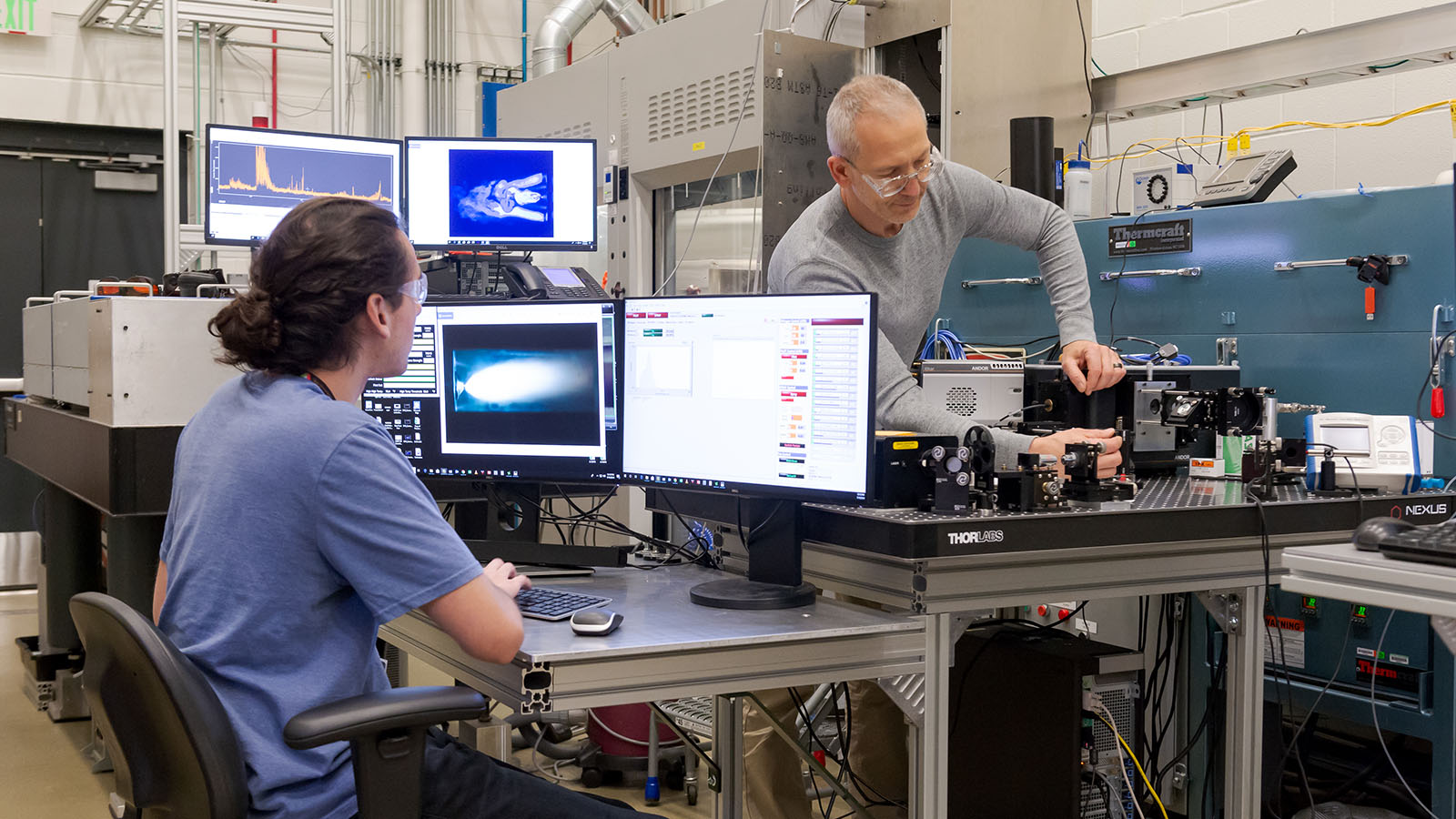Creating nanomaterials with flame spray pyrolysis is complex, but scientists at Argonne have discovered how applying artificial intelligence can lead to an easier process and better performance.
During a tour of the Manufacturing and Engineering Research Facility at the U.S. Department of Energy’s Argonne National Laboratory, Marius Stan, the Intelligent Materials Design lead in Argonne’s Applied Materials Division (AMD), encountered a new experimental setup. As he watched the machine in the experiment, which relies on flame to produce nanomaterials, he had a thought: Could artificial intelligence be used to optimize this complex process?
When asked to explain the process, Stan put it simply: “It’s where scientists put chemicals in a flame and wait for a miracle — for particles to appear at the end of the process, particles that have important properties for a variety of applications.” Flame spray pyrolysis is a technology that enables the manufacturing of nanomaterials in high volumes, which in turn is critical to producing a wide range of industrial materials, like chemical catalysts, battery electrolytes/cathodes and pigments.
Flash forward to July 2020 and publication of “Frame spray pyrolysis optimization via statistics and machine learning” in the journal Materials & Design, a paper authored by an AMD research team that showed the flame spray pyrolysis process could in fact be optimized to create better-performing materials that may help transform domestic manufacturing.
The researchers discovered how to change the chemistry of a material and tweak the machine’s parameters using advanced statistical techniques.
“We decided to look at silica production, to try and influence the quality of the powder,” said Noah Paulson, a computational materials scientist and the paper’s lead author, along with Joe Libera, a principal materials scientist who operates the laboratory’s flame spray pyrolysis, and Stan. “We found that we could use machine learning to control the inputs in the flame spray pyrolysis setup — and it’s complex, there are a lot of different inputs — and obtain desirable outcomes.”
Paulson added that silica was chosen because it’s well suited to computational modeling, but the study’s findings could result in a vast array of improved materials, like battery electrodes for example. “If you have a car and you want to double the range of that car on a single charge, you need better battery materials. That’s what’s limiting us in terms of these applications.”
The role of artificial intelligence in the research was particularly noteworthy. Stan, who has devoted a large part of his career to studying the relationship between humans and machines, said that the level of analysis in this project was so complex as to be almost unfeasible for a human being.
“This is a demonstration that we can create an algorithm and software that can control a process as well, if not better, than a human can. This involved so many parameters that artificial intelligence was necessary to augment our brain in processing this information,” Stan said. “We could not have extracted these findings from the data by observation only, because there were so many dimensions.”
Paulson agreed. “The core of this technology is machine learning that allows us to optimize these processing conditions without human input,” said Paulson. “We’re basically able to zero in on the particle size distribution (we want) in a single day of experiments, versus what could be many weeks.”
Looking ahead, Paulson and Stan pointed to further possible research involving both the experimental and computational sides.
At the Manufacturing and Engineering Research Facility, members of the research team are looking to connect with industrial partners to study how the project software can better control the combustion and chemical processes that are part of flame spray pyrolysis. At the same time, they are hoping to leverage Argonne’s upcoming high performance supercomputer Aurora and its exascale capabilities, to help with the intensive computational nature of the work.
Paulson believes these kinds of efforts will ultimately result in the ability to produce better materials, which is a precursor to progress on many different technological fronts.
“Materials are the real bottleneck,” he explained. “If we can find a way to translate the successes that we see in the lab to materials that can be manufactured at reasonable costs, then we can enable those technologies that the world really needs.”
This research effort was supported by Argonne’s Laboratory Directed Research and Development program. The researchers used Argonne’s Manufacturing and Engineering Research Facility to help obtain results.
Argonne National Laboratory seeks solutions to pressing national problems in science and technology. The nation’s first national laboratory, Argonne conducts leading-edge basic and applied scientific research in virtually every scientific discipline. Argonne researchers work closely with researchers from hundreds of companies, universities, and federal, state and municipal agencies to help them solve their specific problems, advance America’s scientific leadership and prepare the nation for a better future. With employees from more than 60 nations, Argonne is managed by UChicago Argonne, LLC for the U.S. Department of Energy’s Office of Science.
The U.S. Department of Energy’s Office of Science is the single largest supporter of basic research in the physical sciences in the United States and is working to address some of the most pressing challenges of our time. For more information, visit https://energy.gov/science.
